Contact us today:

(847) 934-4500
tdaro@bernardandcompany.com

Contact us today:
(847) 934-4500
tdaro@bernardandcompany.com
Software solution combines maximum performance with minimal implementation time
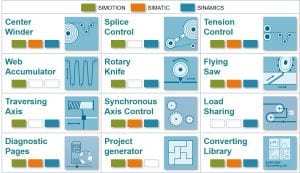 Today’s converting industry requirements are continually increasing, due to higher production rates, more machine flexibility and optimum product quality, combined with new substrates and greater demand for fast changeovers. Industry-specific technologies also continue to demand more from the winding drive and automation systems. Siemens today announces its latest iteration of the popular Converting Toolbox to meet these challenges.
Today’s converting industry requirements are continually increasing, due to higher production rates, more machine flexibility and optimum product quality, combined with new substrates and greater demand for fast changeovers. Industry-specific technologies also continue to demand more from the winding drive and automation systems. Siemens today announces its latest iteration of the popular Converting Toolbox to meet these challenges.
The toolbox enables machine builders to achieve considerably faster time to market by reducing the time required for engineering, programming, commissioning and documentation as much as 80%.
The Siemens Converting Toolbox has separate modules for each of the Siemens product categories typically found on converting machines, including SIMOTION motion controllers, SINAMICS drives and SIMATIC PLCs. SIMOTION is designed for high-performance motion control applications with centralized control in conjunction with the SINAMICS S120 drive system. SINAMICS is ideal for drive-based applications with process-related control implementation in the SINAMICS S120 drive system with graphical drag-and-drop programming. Lastly, the SIMATIC platform applies to centralized converting applications implemented in the PLC control to work in tandem with the SINAMICS S120 drive system.
 Components in the Converting Toolbox take the form of pre-programmed function blocks. Sample applications demonstrate how each function can be efficiently and effectively incorporated into a machine design, whether a modification of a previous generation or an entirely new design. In addition, some applications are ready-to-use, after only minor modifications and include basic HMI functionality. Systems can be implemented in Ladder, Structured text or in a Graphical function block language.
Components in the Converting Toolbox take the form of pre-programmed function blocks. Sample applications demonstrate how each function can be efficiently and effectively incorporated into a machine design, whether a modification of a previous generation or an entirely new design. In addition, some applications are ready-to-use, after only minor modifications and include basic HMI functionality. Systems can be implemented in Ladder, Structured text or in a Graphical function block language.
Additional features of the Converting Toolbox include converting base applications such as: center winder, unwind flying splice control, sectional drive with tension/draw control, accumulator, rotary knife with print mark correction, flying saw, traversing control, synchronized multi axis drive control, load sharing, diagnostics Web pages, project generation tools and converting library process and logistic functions. These function blocks can literally be cut and pasted into a new design, with minimal programming time.
Other specialized application blocks are available upon request.
For more information, please contact:
William Gilbert, Converting Market Manager
Siemens Industry Inc.
5300 Triangle Parkway
Norcross, GA 30092-2538, USA
Tel: +1678 314-4222
William.gilbert@siemens.com
www.usa.siemens.com/converting
Siemens Digital Factory (DF) offers a comprehensive portfolio of seamlessly integrated hardware, software and technology-based services in order to support manufacturing companies worldwide in enhancing the flexibility and efficiency of their manufacturing processes and reducing the time to market of their products.
Siemens Corporation is a U.S. subsidiary of Siemens AG, a global powerhouse focusing on the areas of electrification, automation and digitalization. One of the world’s largest producers of energy-efficient, resource-saving technologies, Siemens is a leading supplier of systems for power generation and transmission as well as medical diagnosis. With approximately 351,000 employees in 190 countries, Siemens reported worldwide revenue of $88.1 billion in fiscal 2016. Siemens in the USA reported revenue of $23.7 billion, including $5.4 billion in exports, and employs approximately 50,000 people throughout all 50 states and Puerto Rico.
Continue reading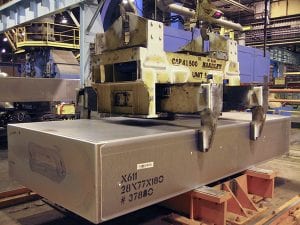 It’s happened too many times: injuries, fatalities, and damage to plant assets resulting from crane-related accidents. The complex work performed by material handling cranes within aerospace, automotive, and metal processing facilities can lead to dangerous and costly accidents. How common is the problem? According to the Crane Inspection and Certification Bureau (CICB), approximately 80 crane-related deaths occur every year. Of all crane-related incidents, 90% are due to human error, 50% of the overall incidents result in a fatality, and 40% of the overall incidents involve someone being struck by the crane or an object that the crane is lifting or moving. Most of these errors correlate to a lack of operator training.
It’s happened too many times: injuries, fatalities, and damage to plant assets resulting from crane-related accidents. The complex work performed by material handling cranes within aerospace, automotive, and metal processing facilities can lead to dangerous and costly accidents. How common is the problem? According to the Crane Inspection and Certification Bureau (CICB), approximately 80 crane-related deaths occur every year. Of all crane-related incidents, 90% are due to human error, 50% of the overall incidents result in a fatality, and 40% of the overall incidents involve someone being struck by the crane or an object that the crane is lifting or moving. Most of these errors correlate to a lack of operator training.
The Solution
Fortunately, recent advancements in digital technologies have fueled innovation in the field of crane control, and new solutions have been developed that are safer and smarter. One unique solution for modernizing cranes was designed to help operators by reducing load sway by a stunning 95%. This innovative solution, EXPERTOPERATOR™, was developed by PaR Systems (PaR) of Shoreview, Minnesota (www.par.com). PaR is a global manufacturer of advanced automation, robotic, and specialty material handling solutions. PaR supports global customers in automotive, aerospace, nuclear, life science, marine and other core industries.
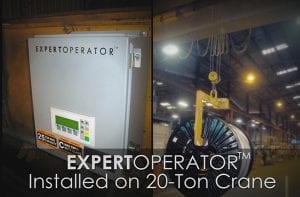 EXPERTOPERATOR is an advanced crane motion control system implemented entirely within the Siemens platform. The system uses equipment such as Simatic S7 PLCs, Simatic HMI Panels, and Scalance W Industrial Wireless Modules. Unique algorithms within PaR’s software enables crane operators to more easily, quickly, and safely control the movements of payloads, such as dies and coils in automotive stamping plants. EXPERTOPERATOR is most effective for applications that require high throughput, and precise manipulation of loads to meet production demands and prevent collisions with sensitive equipment and personnel.
EXPERTOPERATOR is an advanced crane motion control system implemented entirely within the Siemens platform. The system uses equipment such as Simatic S7 PLCs, Simatic HMI Panels, and Scalance W Industrial Wireless Modules. Unique algorithms within PaR’s software enables crane operators to more easily, quickly, and safely control the movements of payloads, such as dies and coils in automotive stamping plants. EXPERTOPERATOR is most effective for applications that require high throughput, and precise manipulation of loads to meet production demands and prevent collisions with sensitive equipment and personnel.
EXPERTOPERATOR is currently installed on over 150 cranes worldwide – many of which are located in automotive, primary metal, and heavy equipment industry facilities. Users have indicated that EXPERTOPERATOR has allowed operators to control their crane loads with 95% less sway and 90% fewer “close calls” or collisions. Optional modules to the EXPERTOPERATOR platform provide robust zone control, sideload/snag prevention, and automatic load positioning.
How material handling customers are benefitting from EXPERTOPERATOR
Across 150 installations, EXPERTOPERATOR has improved personnel safety, reduced damages to equipment, increased efficiency, and reduced maintenance costs.
The evidence that EXPERTOPERATOR makes cranes easier to operate is further demonstrated by data captured through operator studies that measured the frequency of button pushes. While using the technology, operators pressed pendant buttons 60- 80% less than while conducting the same manipulation task without EXPERTOPERATOR. This metric demonstrates that fewer commands are needed to manipulate a swing-free load.
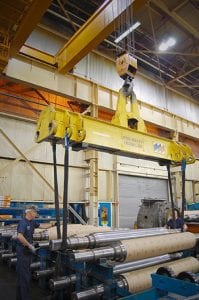 Siemens reliable products and time-saving tools add value PaR Systems relied on Siemens because they place a priority on reliability and quality.
Siemens reliable products and time-saving tools add value PaR Systems relied on Siemens because they place a priority on reliability and quality.
PaR Systems knew their success would depend on their ability to work with a partner who could provide critical hardware that is robust for industrial environments, quick to deploy, and highly configurable.
In material handling crane operations, wireless capability is a key operational factor. The Siemens Scalance W wireless solution offered PaR Systems a wireless component that was reliable and predictable. PaR had experience with non-Siemens wireless solutions in the past that were problematic, both functionally, and from a manufacturer support perspective. The Scalance W wireless solution can be configured to operate in a less congested frequency range (5 GHz), allowing for a more robust wireless signal. Since installing Siemens Scalance W wireless modules as part of their solutions, customers have experienced 100% uptime of their wireless communications. In addition to reliability, the Scalance Wireless Modules offered PaR exceptional customer and OEM technical support.

EXPERTOPERATOR is an advanced crane motion control system that is implemented entirely within the Siemens platform. The system uses equipment such as Simatic S7 PLCs, Simatic HMI Panels, and Scalance W Industrial Wireless Modules.
Time to market is also important to PaR Systems when delivering customer solutions. The Siemens Totally Integrated Automation (TIA) portal provided a platform to shorten engineering time through its simulation tools, programmer productivity tools, and additional diagnostics. PaR Systems benefitted from unique capabilities when programming the Simatic S7 PLCs and Simatic HMI Panel. They were able to dynamically change the cycle time of the main control loop during runtime, which is critical for optimizing the performance of their unique motion control. Debugging capabilities were enhanced because the tool monitors values and updates programs in real time for instantaneous feedback. Such tasks that are tedious and time consuming within other platforms happen automatically and dynamically when using the Siemens TIA solutions.
Material handling requires a fine balance between precision, efficiency, productivity, and most importantly, safety. As a result of the collaboration between PaR Systems and Siemens, new and experienced crane operators around the world can now confidently perform their tasks and contribute to enhanced plant safety and operational efficiency, while reducing equipment maintenance.
To learn more about how Siemens and PaR Systems can help digitalize operations, improve safety, and boost operational efficiency, visit https://www.siemens.com/global/en/home/products/automation.html or https://www.par.com/technologies/crane-controls/
Siemens Industry, Inc.
5300 Triangle Parkway
Norcross, GA 30092
For more information, please contact our Customer Support Center.
Phone: 1-800-241-4453
E-mail: info.us@siemens.com
usa.siemens.com
For specific information on this application, please contact:
Adam Shively
OEM Account Manager
Siemens Digital Factory
Phone: 952-221-3791
E-mail: adam.shively@siemens.com
Support: (800) 333-7421
The technical data presented in this document is based on an actual case or on as-designed parameters, and therefore should not be relied upon for any specific application and does not constitute a performance guarantee for any projects. Actual results are dependent on variable conditions. Accordingly, Siemens does not make representations, warranties, or assurances as to the accuracy, currency or completeness of the content contained herein. If requested, we will provide specific technical data or specifications with respect to any customer‘s particular applications. Our company is constantly involved in engineering and development. For that reason, we reserve the right to modify, at any time, the technology and product specifications contained herein.
About Siemens USA
Siemens Corporation is a U.S. subsidiary of Siemens AG, a global powerhouse focusing on the areas of electrification, automation and digitalization. One of the world’s largest producers of energy-efficient, resource-saving technologies, Siemens is a leading supplier of systems for power generation and transmission as well as medical diagnosis. With approximately 348,000 employees in more than 190 countries, Siemens reported worldwide revenue of $86.2 billion in fiscal 2015. Siemens in the USA reported revenue of $22.4 billion, including $5.5 billion in exports, and employs approximately 50,000 people throughout all 50 states and Puerto Rico.
Continue readingBy Ryan Jarvis, Head of Vertical Markets for Food, Beverage & CPG, Siemens Industry, Inc., Factory Automation
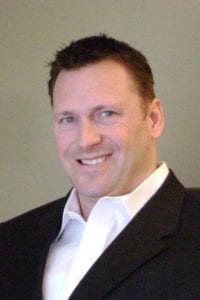 Editor Note: In this article, the author makes the case for the digital factory in food & beverage processing. Much of the input here resulted from a “panel of experts” discussion held recently at the 2018 Manufacturing in America trade event, sponsored by Siemens at Ford Field in downtown Detroit, Michigan.
Editor Note: In this article, the author makes the case for the digital factory in food & beverage processing. Much of the input here resulted from a “panel of experts” discussion held recently at the 2018 Manufacturing in America trade event, sponsored by Siemens at Ford Field in downtown Detroit, Michigan.
In a recent study we conducted at Siemens, where we talked to 40 firms in food & beverage, it was determined that over 50% of firms are already using connected sensors in their operations. Likewise, 60% are using digitalization tools such as track-and-trace to monitor ingredient flow through their supply chain. Finally, over two-thirds of those surveyed are encouraging their suppliers to provide data from their own operations and production processes, improving transparency and creating new opportunities to drive efficiencies.
That’s the good news.
On the flip side, less than half are using advanced data analytics, 85% have lag times over 24 hours between data collection and analysis, plus, perhaps the most challenging fact, over a quarter of the companies surveyed do not yet have a fully defined data management strategy.
In the past, the notion of a food or beverage processor being able to look at a prioritized set of data, in the cloud, in real time, making OEE, shift or even complete plant utilization assessments and sending instantaneous triggers for corrective action to the factory floor with remote, ongoing data back-up for further analysis that included supply chain and even consumer feedback would have been a wish list item.
Not anymore.
With the onset of complete product lifecycle management (PLM) technology, coupled with advanced machine controls, data gathering devices and communications software, with platform-as-a-service capabilities, today’s processor can transition to the digital factory with greater ease and confidence than previously thought possible. As one industry expert observed, “Digitalization is making its entry into our market, but it does require management to have vision, a competent team to do an evaluation and a trusted supply chain of vendors and integrators to make it happen.”
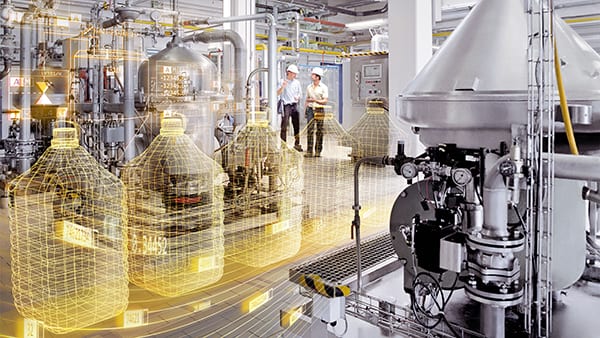
Line efficiency, speed, product validation, production tracking and, a rapidly emerging trend in our business, namely, the need to have flexibility in the line for changeovers to meet the increased variety demands of the buying public are all drivers in this rapidly evolving landscape of the digital factory.
Expanding on some of these points:
During the recent Manufacturing in America event at Ford Field in Detroit, at a Futures Forum sponsored by Siemens, a panel of industry experts from various segments of the food, beverage and CPG market gathered to discuss the trends in digitalization and its impact on their companies, their equipment and, of critical importance, their people, both current and future team members.
This recap summarizes a very lively 90-minute discussion held at the Forum, which was moderated by the author.

The session included a review of the best practices and outlook for digitalization among the manufacturers, equipment builders and others in the supply chain, as well as the editor from a leading automation trade magazine.
While the participants were already engaged at different levels in the digitalization process, one remaining hurdle was exactly that degree of difference, as it impacts their relationship with vendors, distributors, automation integrators and end users alike.
Most all at the forum had significant automation and digital factory initiatives in progress or planned for the near future, a very positive sign for the industry in its quest for global competitiveness.
As consumer demand for product diversification, transparency in ingredient sourcing and even the packaging variances between the local grocer and the big box retail operation all affect the operation of the food & beverage industry, the future opportunities for digitalization and its possibilities for manufacturers will continue to expand at a rapid pace.
Another key concern for the group was the process of introducing employees, including those with decades of experience on the job but little exposure to the digital world, to this emerging trend. Most companies were actively engaged in training, both for the current labor force and the next generation. It was agreed that the machines and equipment in the factory needed to reflect the HMI qualities of the consumer electronics that occupy so much of modern life today. As a collateral benefit, the digital factory, by definition, would attract more young talent to enter the manufacturing field. As one participant put it, “They expect digital nowadays.”
 On the logistics of implementing digitalization, it was unanimously agreed that one-off projects would not achieve the desired results with any efficiencies. The better approach was a thorough plan, developed by the end user working with their machinery, equipment and automation suppliers, as well as customers, to achieve an optimum hierarchy of needs.
On the logistics of implementing digitalization, it was unanimously agreed that one-off projects would not achieve the desired results with any efficiencies. The better approach was a thorough plan, developed by the end user working with their machinery, equipment and automation suppliers, as well as customers, to achieve an optimum hierarchy of needs.
All agreed line efficiency and speed were paramount on the scale of basic requirements for an effective system. Product validation and production tracking in a digital environment means analyzing not merely collecting data, in real time. The goal is delivery of actionable knowledge about the process, they concurred.
For the factory floor, the impact of robotics was a very lively topic of discussion. It was noted that “…robots can replace but also augment people and this will require an entirely new paradigm of ergonomics.”
On the financial front, it was agreed that driving management to implement digitalization must be more than a decision about dollars. The future of the companies that were major players in food & beverage 50 years ago was directly tied to their willingness to adapt every aspect of their companies to the changing tastes and purchasing practices of the buying public. Today, there are myriad means available for the younger generation to acquire everything they touch, wear, taste, drive and consume. The smart companies, it was mused, will be the SMART companies, meaning those who incorporate the digital factory precepts into their entire operation and company vision.
The following list was suggested as areas where digitalization would have influence in the industry today…
Finally, the fun part…an outlook overview on the future of the market, from the perspective of the participants on the panel and in the audience. All the following areas were discussed as potential and, in some cases, already initiated areas for digitalization to become a positive factor…
Author:
Ryan Jarvis may be contacted for comments or questions at ryan.jarvis@siemens.com.
About Siemens USA
Siemens Corporation is a U.S. subsidiary of Siemens AG, a global powerhouse focusing on the areas of electrification, automation and digitalization. One of the world’s largest producers of energy-efficient, resource-saving technologies, Siemens is a leading supplier of systems for power generation and transmission as well as medical diagnosis. With approximately 348,000 employees in more than 190 countries, Siemens reported worldwide revenue of $86.2 billion in fiscal 2015. Siemens in the USA reported revenue of $22.4 billion, including $5.5 billion in exports, and employs approximately 50,000 people throughout all 50 states and Puerto Rico.
 The Multi-Carrier-System (MCS), a configurable transport system, is jointly manufactured by Siemens and Festo. The MCS delivers unparalleled levels of flexibility and can be easily incorporated into existing processing and packaging environments.
The Multi-Carrier-System (MCS), a configurable transport system, is jointly manufactured by Siemens and Festo. The MCS delivers unparalleled levels of flexibility and can be easily incorporated into existing processing and packaging environments.
The MCS addresses the acute need for flexibility in modern manufacturing and production environments driven by increasingly complex product diversity, shorter product life cycles and growing levels of mass customization.
In this configurable transport system, the transport carriages, which are driven by linear motors, are flexibly moved to the individual units, e.g. filling, closing or labeling unit. The system moves freely and exactly synchronously to the process and can be integrated in the existing intralogistics – including seamless loading and unloading of the carriages. The other transport paths remain unchanged. The modular concept allows a quick conversion of the machine to different formats, other product types or seasonal requirements. The integrated concept allows control of the transport movements and Motion Control functionality as well as the coordination of additional machine module.
The MCS provides many benefits:
The MCS incorporates options for processing and packaging customers to achieve goals for advanced manufacturing. Some of these options are flexible electromechanical design for economic production down to batch sizes of one and decentralized sensors and intelligence incorporated within the work piece carriers and drives.
The modular servo controller and the motion controller also fully reflect the cyber-physical integration of Industrie 4.0 systems. The system provides OPC Unified Architecture (OPC-UA) messaging enabling open integration into Industrie 4.0 architectures and enterprise systems such as SAP.
Siemens offers a comprehensive portfolio of seamlessly integrated hardware, software and technology-based services in all aspects of packaging. Siemens supports the packaging industry on an industrial scale enhancing flexibility and efficiency processes and reducing the time to market.
Contact for product inquiries and information:
Mathias Radziwill
Phone: (800) 743-6367
Email: mathias.radziwill@siemens.com
Follow us on Twitter at: www.twitter.com/siemens_press
About Siemens USA
Siemens Corporation is a U.S. subsidiary of Siemens AG, a global powerhouse focusing on the areas of electrification, automation and digitalization. With approximately 348,000 employees in more than 190 countries, Siemens reported worldwide revenue of $86.2 billion in fiscal 2015. Siemens in the USA reported revenue of $22.4 billion, including $5.5 billion in exports, and employs approximately 50,000 people throughout all 50 states and Puerto Rico.
About Festo
Festo is a leading manufacturer of pneumatic and electromechanical systems, components, and controls for process and industrial automation. For more than 40 years, Festo Corporation has continuously elevated the state of manufacturing with innovations and optimized motion control solutions that deliver higher performing, more profitable automated manufacturing and processing equipment.
Siemens offers a new servo package consisting of drive, motor and controller for
a wide variety of motion control applications
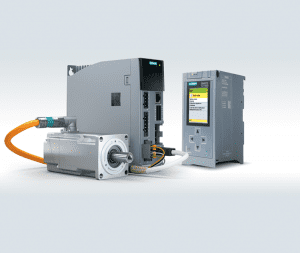 With its Sinamics S210 converter designed specifically for use with the newly developed Simotics S-1FK2 motors, Siemens is offering a new and innovative servo drive system in an initial offering from 50–750 watts. The converters come with integrated safety functions and enable rapid engineering via motion technology objects in Simatic S7-1500 controllers. They are connected to higher-level controllers via Profinet and are quickly and easily programmed by automatic motor parameterization and one-button tuning. Typical uses for this new drive system include packaging machines, handling applications such as pick-and-place, wood and plastics processing, as well as life sciences and digital printing.
With its Sinamics S210 converter designed specifically for use with the newly developed Simotics S-1FK2 motors, Siemens is offering a new and innovative servo drive system in an initial offering from 50–750 watts. The converters come with integrated safety functions and enable rapid engineering via motion technology objects in Simatic S7-1500 controllers. They are connected to higher-level controllers via Profinet and are quickly and easily programmed by automatic motor parameterization and one-button tuning. Typical uses for this new drive system include packaging machines, handling applications such as pick-and-place, wood and plastics processing, as well as life sciences and digital printing.
“The Sinamics S210 focuses on highly-dynamic motor axis control, while the connected controller, for example the Simatic S7-1500 or S7-1500T with its extended motion control functionality, takes complete charge of positioning functions for the connected drive axes.”, says Craig Nelson, product manager for Sinamics S-series drives.
The Sinamics S210 is commissioned using an integrated web server. One-button tuning functionality allows automatic optimization of control parameters, taking into consideration the behavior of the connected mechanics by different dynamic levels.
Integrated safety functions include STO (Safe Torque Off) and SS1 (Safe Stop 1). Both can be actuated using Profisafe, STO additionally using a terminal. Additional functions are currently in the preparation stage. In conjunction with the rapid sampling and smart control algorithms of the Sinamics S210, a high-grade encoder system on the Simotics 1FK2 motor and the combination of low rotor inertia and high overload capability, allow the servomotors to achieve outstanding dynamic performance and precision.
Simotics 1FK2 motors are connected to the converters using a “One Cable Connection” (OCC), which includes the power conductors, encoder signal and brake — all grouped together in an exceptionally thin cable measuring just 9 millimeters in diameter. Its minimal cross-section makes the OCC cable thinner, lighter and more flexible than previous power cables, considerably simplifying the cabling process. This results in a single motor plug connector and connection at the converter is just as simple with user-friendly plugs with push-in terminals on the front.
To learn more about the Sinamics S210 servo system, please visit: usa.siemens.com/sinamics-s210
The new Sinamics S210 drive system with Simotics S-1FK2 servomotors and Simatic S7-1500 controllers offer users a highly-dynamic servo package with integrated safety functions and quick commissioning.
Siemens Digital Factory (DF) offers a comprehensive portfolio of seamlessly integrated hardware, software and technology-based services in order to support manufacturing companies worldwide in enhancing the flexibility and efficiency of their manufacturing processes and reducing the time to market of their products.
For specific product information and inquiries, send an e-mail to: mc.us@siemens.com
Siemens Corporation is a U.S. subsidiary of Siemens AG, a global powerhouse focusing on the areas of electrification, automation and digitalization. One of the world’s largest producers of energy-efficient, resource-saving technologies, Siemens is a leading supplier of systems for power generation and transmission as well as medical diagnosis. With approximately 351,000 employees in 190 countries, Siemens reported worldwide revenue of $88.1 billion in fiscal 2016. Siemens in the USA reported revenue of $23.7 billion, including $5.4 billion in exports, and employs approximately 50,000 people throughout all 50 states and Puerto Rico.
Universities and technical schools trying to keep up with advances in digital manufacturing often find themselves behind industry. However, I was privileged to visit one university, the University South Carolina, which will now be an important exception. Founded in 1801, USC is one of the oldest universities in the US with a history of creating the most innovative learning programs dating back to its first curriculum obtained from Oxford University. Today, USC is establishing a one of a kind Digital Factory Lab that combines technology and coolness to inspire and educate its students.
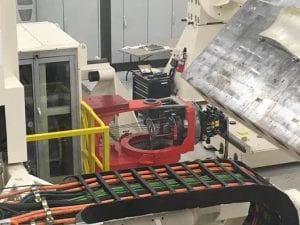 This past week, Siemens announced a partnership to help the University of South Carolina to accomplish this goal with an in-kind grant of hardware and software. “Welcome to Brain Power USA! Siemens is investing $628 million in high tech training for 4th industrial revolution jobs in South Carolina,” said Henry McMaster, South Carolina Governor. By providing students with this hands-on experience on software and hardware across USC’s engineering curriculum and in research programs, Siemens is helping prepare a highly-skilled STEM workforce for the advanced manufacturing industry, including the aerospace industry, which has experienced an 11.4% employment growth rate in South Carolina since 2010.
This past week, Siemens announced a partnership to help the University of South Carolina to accomplish this goal with an in-kind grant of hardware and software. “Welcome to Brain Power USA! Siemens is investing $628 million in high tech training for 4th industrial revolution jobs in South Carolina,” said Henry McMaster, South Carolina Governor. By providing students with this hands-on experience on software and hardware across USC’s engineering curriculum and in research programs, Siemens is helping prepare a highly-skilled STEM workforce for the advanced manufacturing industry, including the aerospace industry, which has experienced an 11.4% employment growth rate in South Carolina since 2010.
Ramy Harik is one of the professors at USC and he told me that these new resources will be put to good use. Already his students have been involved in working with composites, designing new ways of analyzing data for the helicopter AH-64 Apache airframe and developing insights into that aircraft’s mechanical operation for the Army. More innovations are sure to come. For instance, beginning this fall students will also be able to pursue a major in aerospace engineering.
In recent years, the state of South Carolina has become a magnet for sophisticated manufacturing particularly in aerospace, automotive and tire. As a result of working with these companies to deploy high-tech manufacturing and by supporting vocational learning in the state through USC’s College of Engineering and Computing and the McNAIR Center for Aerospace Innovation and Research, USC has grown into a major research university. Specifically, the McNAIR Center is aligned with two dozen educational and government partners, and a group of industry partners that include The Boeing Company, Fokker Aerostructures, KUKA Robotics, Ingersoll Machine Tools, Gulfstream and more.
 The recent gift by Siemens to University of South Carolina will contribute to the state’s overall goal to become the smartest manufacturing state in the United States. I know this is not only important to the Governor of South Carolina, but also to the USC President Harris Pastides who said, “We’re proud that our researchers and students at the College of Engineering and Computing, McNAIR Aerospace Center and the entire USC system, will play a role in discovering new manufacturing technologies and will be better prepared to take on the jobs of tomorrow in South Carolina and beyond.”
The recent gift by Siemens to University of South Carolina will contribute to the state’s overall goal to become the smartest manufacturing state in the United States. I know this is not only important to the Governor of South Carolina, but also to the USC President Harris Pastides who said, “We’re proud that our researchers and students at the College of Engineering and Computing, McNAIR Aerospace Center and the entire USC system, will play a role in discovering new manufacturing technologies and will be better prepared to take on the jobs of tomorrow in South Carolina and beyond.”
To date, South Carolina’s business, education and state government partnerships have created jobs for more than 55,000 South Carolinians in the larger aerospace industry. As Raj Batra, President, Siemens Digital Factory Division, U.S., said, “Aerospace companies throughout South Carolina are heavily reliant on automation and digitalization as well as well-trained employees. Our partnership with the University of South Carolina will provide valuable experiential training with both software and hardware, providing the next generation workforce with the skills they need to be successful.”
Far from lagging, educators in South Carolina are working hard to stay out front. While I was at dinner, USC’s Hossein Haj-Hariri, Dean of the College of Engineering and Computing, told me “We are going to work very hard to make this the best investment that Siemens has ever made.” I am proud to be part of a company that will match that enthusiasm and make this a program known for enabling students to be competitive for jobs throughout the world.
Governor Henry McMaster, we are ready to help you build the workforce of tomorrow.
Siemens Industry, Inc.
Alisa Coffey
(678) 427-8319
alisa.coffey@siemens.com
About Siemens USA
Siemens Corporation is a U.S. subsidiary of Siemens AG, a global powerhouse focusing on the areas of electrification, automation and digitalization. One of the world’s largest producers of energy-efficient, resource-saving technologies, Siemens is a leading supplier of systems for power generation and transmission as well as medical diagnosis. With approximately 348,000 employees in more than 190 countries, Siemens reported worldwide revenue of $86.2 billion in fiscal 2015. Siemens in the USA reported revenue of $22.4 billion, including $5.5 billion in exports, and employs approximately 50,000 people throughout all 50 states and Puerto Rico.
Effective immediately, Siemens announces the standard 12-month warranty on newly purchased Sinamics DCM DC drive products, including DC converters, base drives, enclosure cabinets and control modules, has been extended by two years, to a total of three years from date of manufacture.
This extended warranty, according to company sources, applies to new orders only and previously placed orders cannot be included in this offer. The extended warranty is exclusive of any other extended warranty program or initiative offered by Siemens or its sales distribution network.
The offer applies to all products in the DCM drive products line and no registration or application is required for compliance.

Siemens has extended the warranty on its Sinamics DCM DC drive products, including DC drives, base drives, enclosure cabinets and control modules, by two years, to a total of three years from date of manufacture, effective immediately.
Contact for journalists:
Siemens
John Meyer
(847) 640-1595
john.meyer@siemens.com
Siemens
Hollie Davis
(770) 751-4882
hollie.davis@siemens.com
For specific product information and inquiries, call (800) 879-8079 ext. Marketing Communications or send an e-mail to: mc.us@siemens.com. Or, go to the website for full details: www.usa.siemens.com/drives.
About Siemens USA
Siemens Corporation is a U.S. subsidiary of Siemens AG, a global powerhouse focusing on the areas of electrification, automation and digitalization. One of the world’s largest producers of energy-efficient, resource-saving technologies, Siemens is a leading supplier of systems for power generation and transmission as well as medical diagnosis. With approximately 348,000 employees in more than 190 countries, Siemens reported worldwide revenue of $86.2 billion in fiscal 2015. Siemens in the USA reported revenue of $22.4 billion, including $5.5 billion in exports, and employs approximately 50,000 people throughout all 50 states and Puerto Rico.
Siemens has expanded its extensive drive portfolio for servo applications to include the Simotics S-1FG1 servo geared motors, which are designed for use with the Sinamics S120 drive system. Sinamics S120 drives and Simotics S-1FG1 servo geared motors are an integral component of Siemens Totally Integrated Automation (TIA), which reduces engineering time and costs. Pre-fabricated Motion-Connect signal and power cables offer an easy and reliable method of connecting the components. The units have electronic rating plates and the motors are connected via the Drive-Cliq system interface, so the system can be brought online quickly.

Siemens has expanded its extensive drive portfolio for servo applications to include the Simotics S-1FG1 servo geared motor that is optimally harmonized with the Sinamics S120 converter system. The complete integration of this drive system into Totally Integrated Automation (TIA) makes configuration and commissioning easy.
The engineering of the Simotics S-1FG1 servo geared motor includes high efficiency and low torsional backlash for precise, dynamic motion sequences and is available in the following versions: helical, parallel shaft, bevel and helical worm gearboxes with up to 25 transmission ratios, depending upon the type of gear and gear size required. The helical gearing of the gearboxes reduces noise and offers high efficiency.
With its highly integrated functionality and scalable number of axes, the S120 drives are suitable for use in a number of demanding motion control applications such as printing and packaging machines, storage and retrieval machines, material handling conveyor systems and dosing pumps. The high-performance single and coordinated multi-axis drives with servo control enables ideal solutions for an increase in overall line productivity and flexibility.
The Sinamics S120 drive system is available in blocksize and booksize hardware types for use with the servo geared motors. The power units or motor modules in booksize format have been redesigned in the 3–30A range. Power units with a triple overload capability and the integration of the motor connection system into the motor module save a considerable amount of space in both height and width in the control cabinet. The newly developed connection method allows fast, easy and reliable assembly and wiring, while the optimized shielding design and improved thermal separation between power semi-conductor and electronics also ensure greater ruggedness.
The small diameter of the plug-on pinion inserted into the motor shaft enables the first gear stage to render a high transmission ratio. In turn, this means that a two-stage gearbox can be used for many applications as an alternative to a more costly three-stage unit.
Contact for journalists:
Siemens
John Meyer
(847) 640-1595
john.meyer@siemens.com
Siemens
Hollie Davis
(770) 751-4882
hollie.davis@siemens.com
For specific product information and inquiries, call (800) 879-8079 ext. Marketing Communications or send an e-mail to: mc.us@siemens.com.
About Siemens USA
Siemens Corporation is a U.S. subsidiary of Siemens AG, a global powerhouse focusing on the areas of electrification, automation and digitalization. One of the world’s largest producers of energy-efficient, resource-saving technologies, Siemens is a leading supplier of systems for power generation and transmission as well as medical diagnosis. With approximately 348,000 employees in more than 190 countries, Siemens reported worldwide revenue of $86.2 billion in fiscal 2015. Siemens in the USA reported revenue of $22.4 billion, including $5.5 billion in exports, and employs approximately 50,000 people throughout all 50 states and Puerto Rico.
The Modular Tire Measurement System (MTMS) is a tire uniformity, dynamic tire balance measurement and tire geometry inspection system combined in a single unit for optimum performance, minimal manpower hours and optimum floorspace utilization in tire plant facilites; system combines Micro-Poise tire measurement technology with advanced Siemens servo motors, drives and TIA Portal PLCs plus enhanced communications protocol to provide the best measurement and cycle time on the market.
Micro-Poise Measurement Systems, an Ametek company with over 90 years experience in service to the tire and auto industries and located in Streetsboro, Ohio, today announces plans to replace an existing tire measurement system at a production facility of a major American tire builder. According to John Clark, Director of Product Management for new machinery at Micro-Poise, the customer presented Micro-Poise with several challenges, including the replacement of an existing system within the same footprint, while providing the customer with the most advanced tire measurement and data communications technologies available. The selection of the MTMS from Micro-Poise will afford the end user complete tire testing in one unit, with the best measurement quality and cycle time available, while also providing a reduced footprint for optimum utilization of floor space and reduced manpower hours required.
The MTMS combines three proprietary technologies into a single system, including Micro-Poise ASTEC™ FX tire uniformity measurement, AkroDYNE™ FX dynamic balance measurement and TGIS-SL® tire geometry inspection. The resulting advantages for the end user, according to company sources, will be a minimum tire testing cycle time, reduction of manpower hours, installation of the entire system within the footprint of the existing D70 system installed globally at numerous tire plants and reduced downtime, due to the materials handling configuration and transfer mechanisms on the MTMS.
To help produce the required system, Micro-Poise engineering has turned to its longtime partner Siemens for assistance with the motion and machine control, plus a communications platform that will seamlessly transmit all data gathered upstream to the end user’s production management team. The Siemens product and software support onboard the MTMS will include TIA Portal Simatic S7 PLCs, Sinamics drives, Simotics motors, advanced fault detection and alarm sequencing, diagnostic prioritization software on the HMI for faster recognition by the operators, higher levels of data gathering for production management analysis and a seamless Profinet/Ethernet communications platform.
The new MTMS is currently in the build and test phases at Micro-Poise, with delivery to the customer slated for the Fall of 2016. During early 2017, additional linking of the machine to the entire production protocol will occur.
The main components of the MTMS design include:
The Modular Tire Measurement System (MTMS) 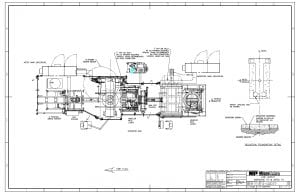 from Micro-Poise combines tire uniformity, dynamic balance measurement and tire geometry inspection into a single unit with full transfer mechanisms to speed cycle time, reduce manpower hours and conserve floor space. In its most efficient configuration, the total system cycle time is said to be the fastest in the industry. In addition, each individual measurement station insures the best measurement with no compromise in precision and accuracy. Siemens motion control technologies and software are key to overall machine performance and data communications, according to Micro-Poise sources.
from Micro-Poise combines tire uniformity, dynamic balance measurement and tire geometry inspection into a single unit with full transfer mechanisms to speed cycle time, reduce manpower hours and conserve floor space. In its most efficient configuration, the total system cycle time is said to be the fastest in the industry. In addition, each individual measurement station insures the best measurement with no compromise in precision and accuracy. Siemens motion control technologies and software are key to overall machine performance and data communications, according to Micro-Poise sources.
Contact for journalists:
Siemens Industry, Inc.
Alisa Coffey
(678) 427-8319
alisa.coffey@siemens.com
Siemens Industry, Inc.
Hollie Davis
(770) 751-4882
hollie.davis@siemens.com
For more information on this news release, interested parties may also contact:
AMETEK Micro-Poise Measurements Systems
555 Mondial Parkway
Streetsboro, OH 44241
Phone: (330) 541-9100
Stacey Urdiales, Marketing Services & Documentation Manager
stacey.urdiales@ametek.com
About Siemens USA
Siemens Corporation is a U.S. subsidiary of Siemens AG, a global powerhouse focusing on the areas of electrification, automation and digitalization. One of the world’s largest producers of energy-efficient, resource-saving technologies, Siemens is a leading supplier of systems for power generation and transmission as well as medical diagnosis. With approximately 348,000 employees in more than 190 countries, Siemens reported worldwide revenue of $86.2 billion in fiscal 2015. Siemens in the USA reported revenue of $22.4 billion, including $5.5 billion in exports, and employs approximately 50,000 people throughout all 50 states and Puerto Rico.
Machine builder utilizes Siemens hardware, software and communications platform on lines up to 11 layers of co-extrusion; achieving <1ºF of temp variation
Hosokawa Alpine American (Natick, Massachusetts) is a leading supplier of blown film extrusion systems to the North American plastics industry; with standard lines ranging from single-layer to 9-layer co-extrusion. The company recently rolled out its new 11-Layer X-Die line, featuring an advanced zone temperature control system that enables faster changes in recipe and data acquisition to allow on-the-fly adjustments for enhanced production performance. A recent installation of this system at a large multi-national Blown Film Company is already yielding trackable performance improvements at their plant.
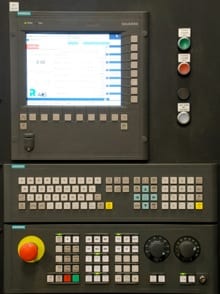
Hosokawa Alpine blown film system, the X-Die with 11 lines
As Alpine’s VP of Engineering Jay Ragusa observes, “We had a very successful machine design from the 1990’s and it had performed extremely well, but we saw dramatic improvements in new controls and data transmission technology from our longtime partner Siemens together with their local distributor, Dittman & Greer (Middletown, Connecticut), a specialist in electric temperature systems and machine controls.” Among these advancements, Ragusa notes, are a new zone temperature control system, as well as the Box PC with full automation and visualization software onboard running with WinCC.
Alpine had a “light bulb” moment, as Ragusa explains. “We quickly realized this new system would give us the ability to design a machine with a complete zone temperature control system and remote I/O, plus the necessary hardware and touchscreen HMI to give operators and production management an entirely new approach to in-process control and product quality monitoring”.
The company conducted its due diligence, calling in various competitors for the business. Thorough testing in the Alpine lab pilot plant was conducted, with strong emphasis on component failure analysis, system fault detection and the robust qualities of the competing systems for 24/7 use in the harsh environment of the blown film industry.
“Beyond those benchmarks of evaluation,” Ragusa continues, “we were seeking a system with enhanced flexibility, so we could provide our customers a better way to change recipes in a quicker, more efficient manner, while maintaining a very high degree of product quality.”

Siemens motor and drive assembly, plus PLC and HMI, control the processing and allow fast recipe changes.
After the completed testing and evaluation process in-house at Alpine, the decision was made to move forward with the Siemens system, comprising a new zone temperature control, Profinet communication platform, motors, drives, PLC and touchscreen HMI.
As the new system and other improvements were implemented into the first machine built and test-run at Alpine, a documented higher yield was achieved, with a higher degree of control accuracy. Ragusa notes there is an additional benefit of real-time monitoring and adjustment of all machine conditions.
This new machine included up to 120 separate temperature control zones. According to Ragusa typical systems allow for a 2º-3ºF variation in zone temperatures; with the new system that variation is reduced to less than 1ºF.
Jay Ragusa also details other system improvements made by Alpine on the new machine. “The new industrial flat panel on the PC has a wider screen for easy viewability. Plus, our older system, while modular, had little remote I/O and the new system brings us that benefit, too. The auto-tune function, combined with the better CPU in the PLC, gives us a much stronger package of internal software in combination with hardware. Since we were making the transition within a Siemens protocol, no significant software conversion was required and all data feeds continue on Profinet.”

A temperature accuracy better than 1ºF per zone yields superior, consistent quality in blown films.
Data transmission overall has also improved, he notes, as the communication speeds are significantly faster, plus the open architecture of the system can convey all data to the other departments seamlessly.
Two more advantages of the Siemens system include the plug-and-play remote I/O hardware and the open architecture of the control system. The quick- connect, plug-and-play remote I/O hardware reduces installation, commissioning and replacement time of the system hardware. The open architecture of the control system allows end-user adjustment of control parameters to suit each specific application and stores thousands of recipe data points. Alpine routinely customizes the front end of the controller HMI to facilitate easier customer training and a seamless transition from legacy systems for operators in use. As Ragusa notes, “The field wiring savings alone are incredible, as our machines are fully tested in our facility, then dismantled and assembled onsite at the customer location.”
On the maintenance side, a customer can quickly determine component faults and either take corrective action or literally order a new component from the onboard controller, as the Siemens protocol offers internet connectivity.
For more information on this story, please contact:
HOSOKAWA ALPINE AMERICAN
5 Michigan Drive
Natick, MA 01760
Phone: 508-655-1123
www.halpine.com
Attention: Jay Ragusa, VP of Engineering or Alana Carr, Marketing Coordinator
or
SIEMENS
Digital Factory
Factory Automation
5300 Triangle Parkway
Norcross, GA 30092
Phone: 770-871-3848
www.usa.siemens.com/drives
Attention: Hollie Davis or Alisa Coffey
About Siemens USA
Siemens Corporation is a U.S. subsidiary of Siemens AG, a global powerhouse focusing on the areas of electrification, automation and digitalization. One of the world’s largest producers of energy-efficient, resource-saving technologies, Siemens is a leading supplier of systems for power generation and transmission as well as medical diagnosis. With approximately 348,000 employees in more than 190 countries, Siemens reported worldwide revenue of $86.2 billion in fiscal 2015. Siemens in the USA reported revenue of $22.4 billion, including $5.5 billion in exports, and employs approximately 50,000 people throughout all 50 states and Puerto Rico.